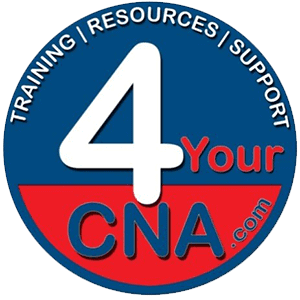Skills Review Videos
CNA Skills
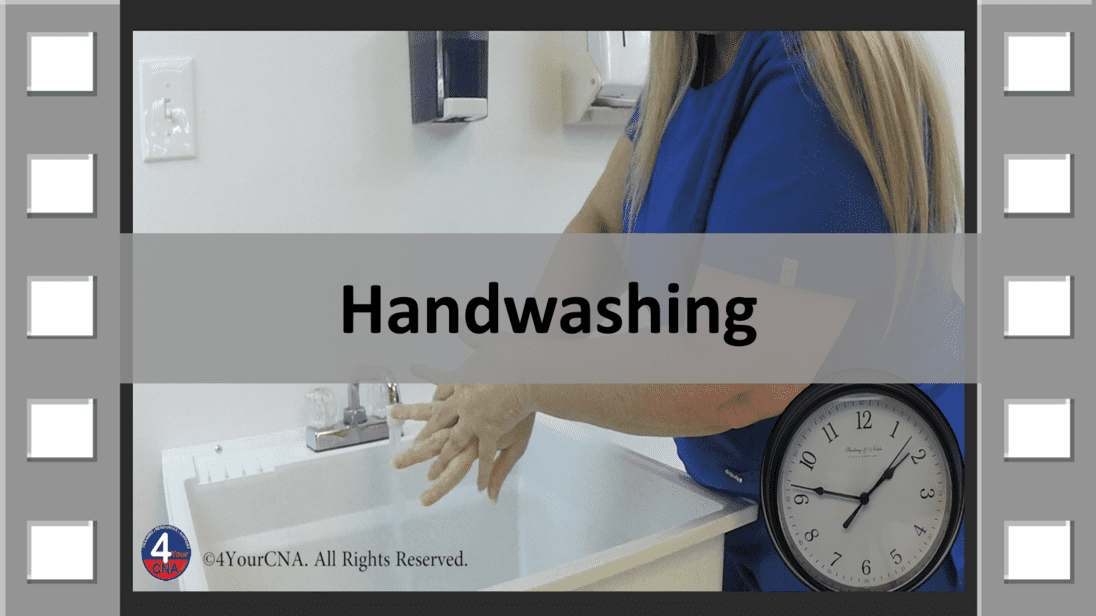
2:50
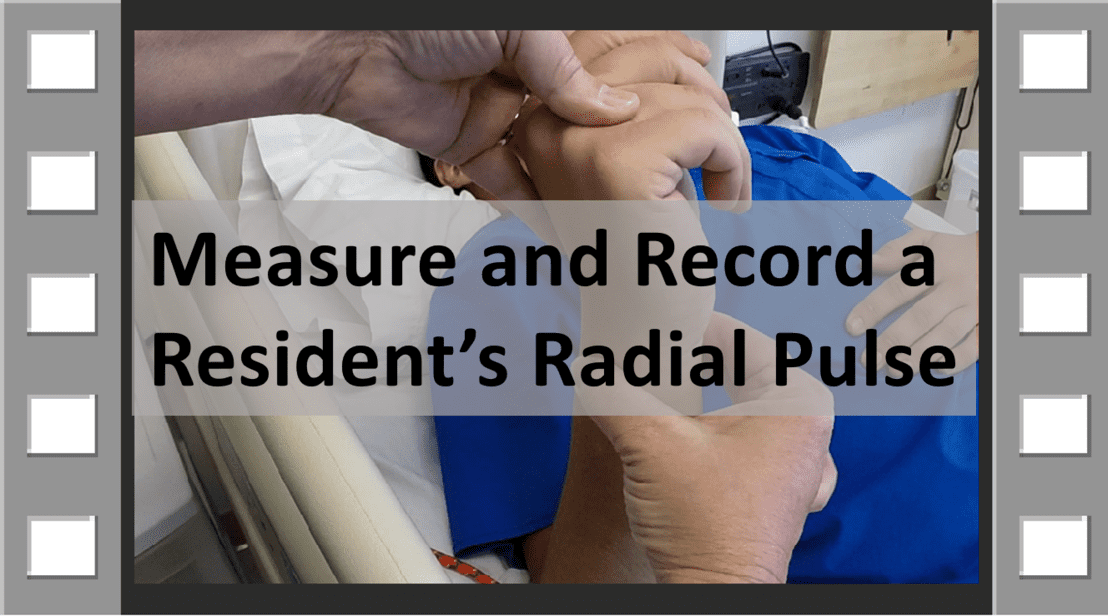
2:50
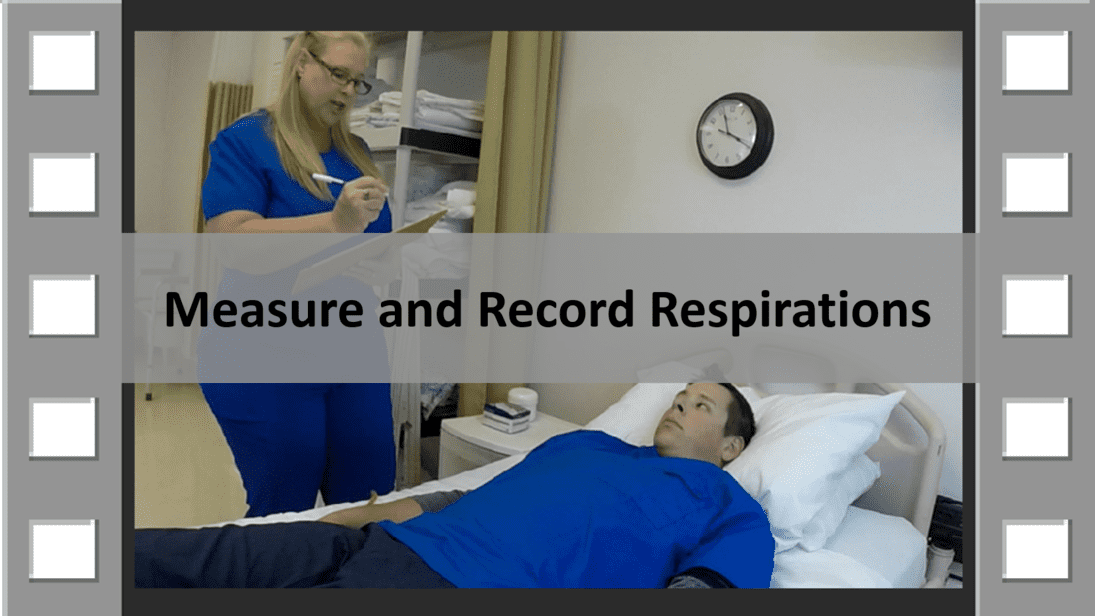
3:21
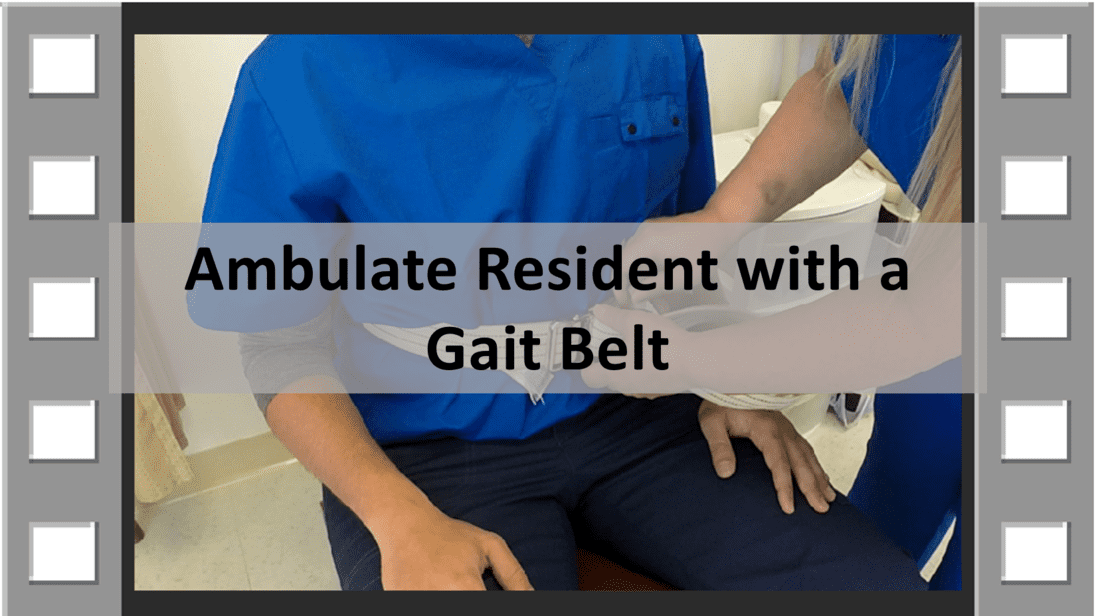
2:55
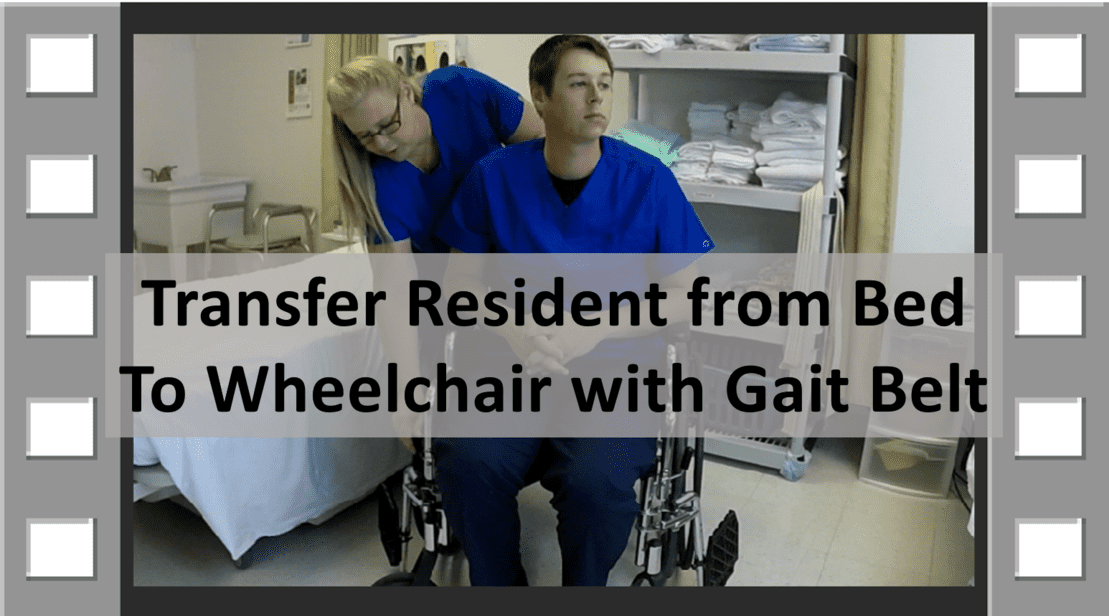
4:14
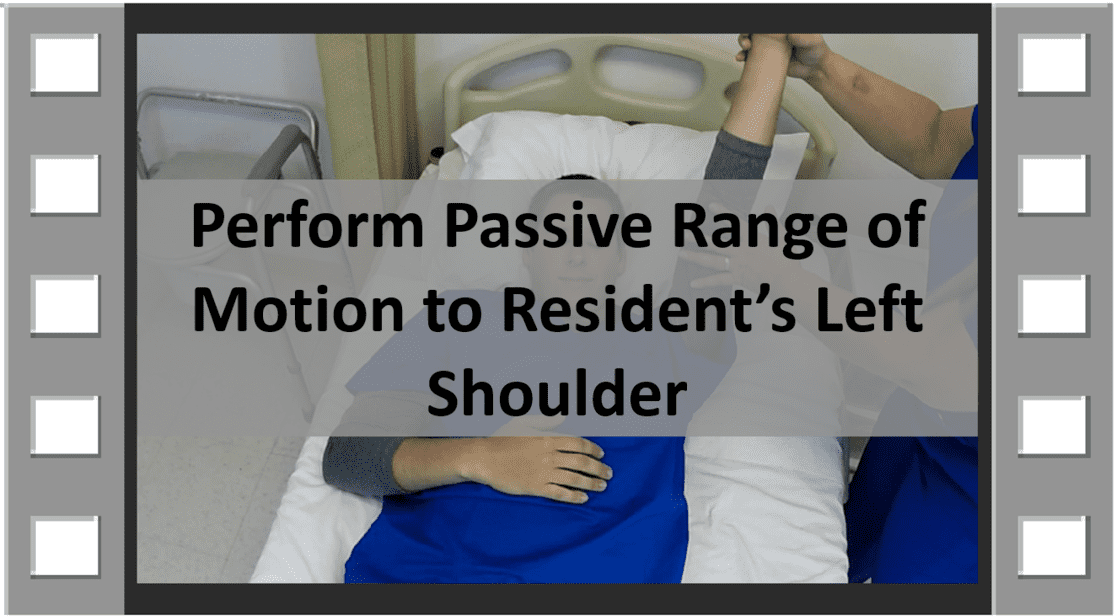
2:41
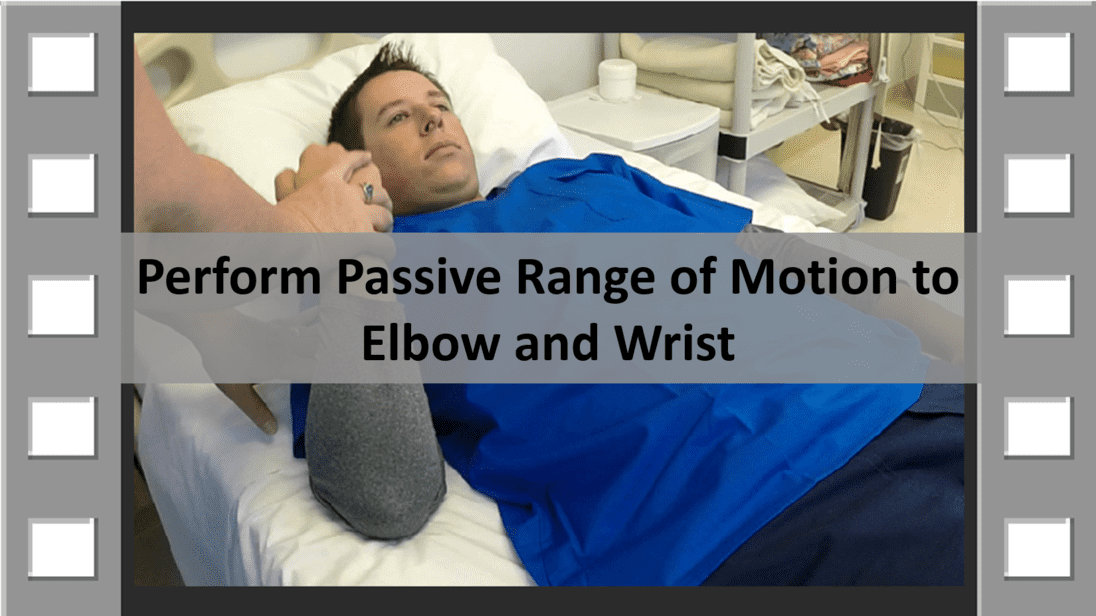
2:19
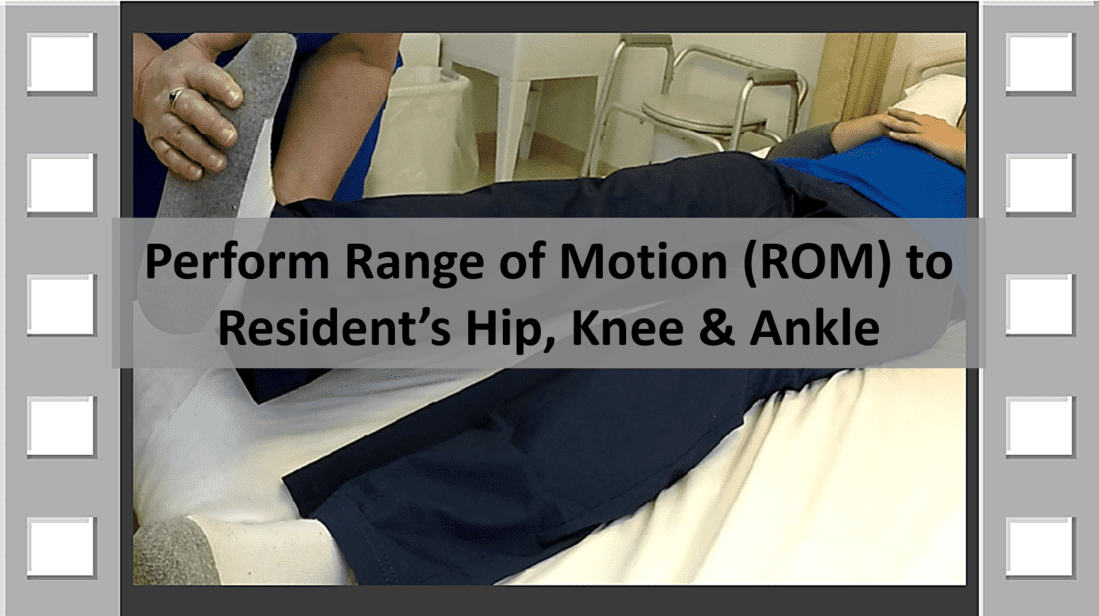
2:37
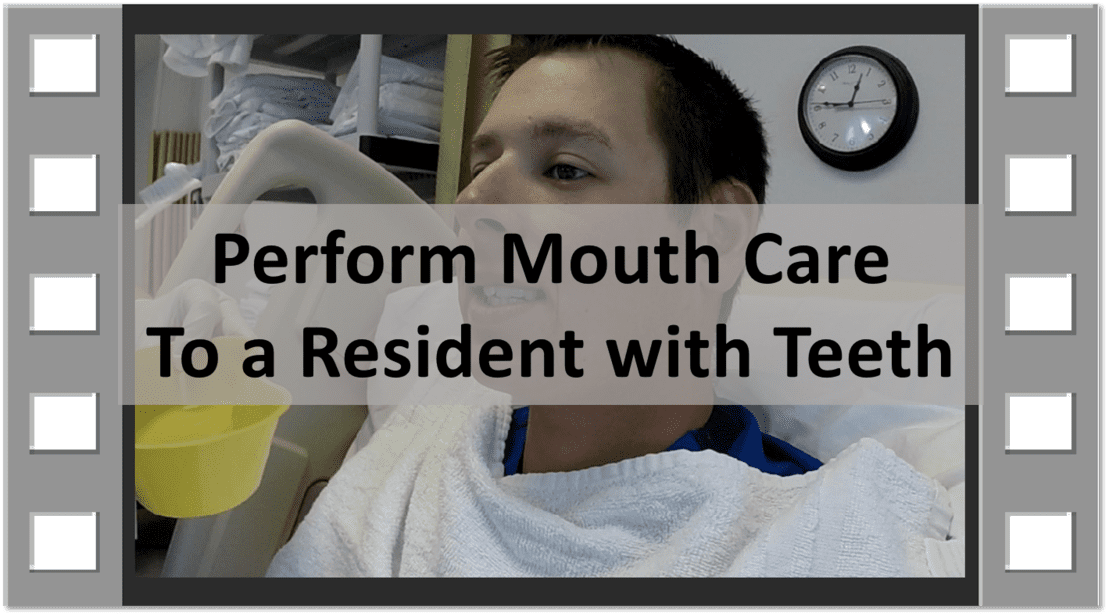
5:27

8:01

7:05

3:45
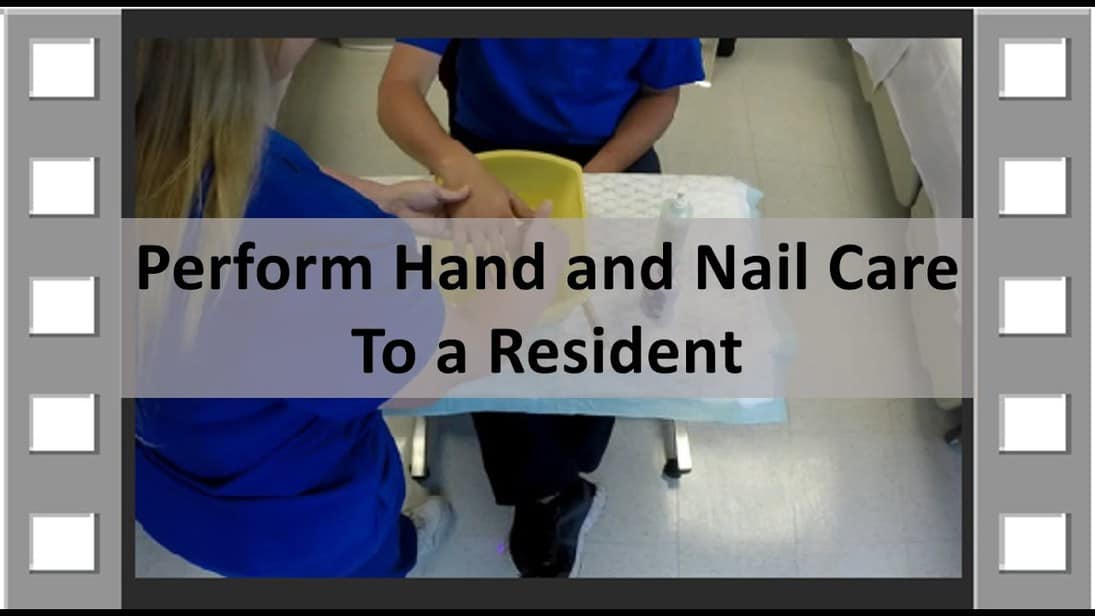
6:34
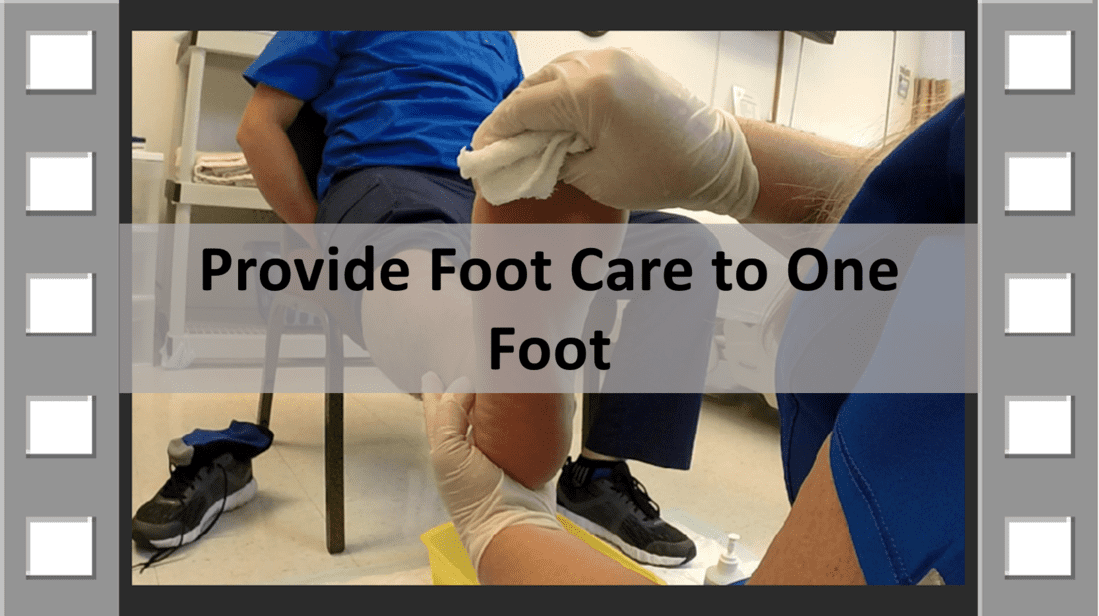
6:24
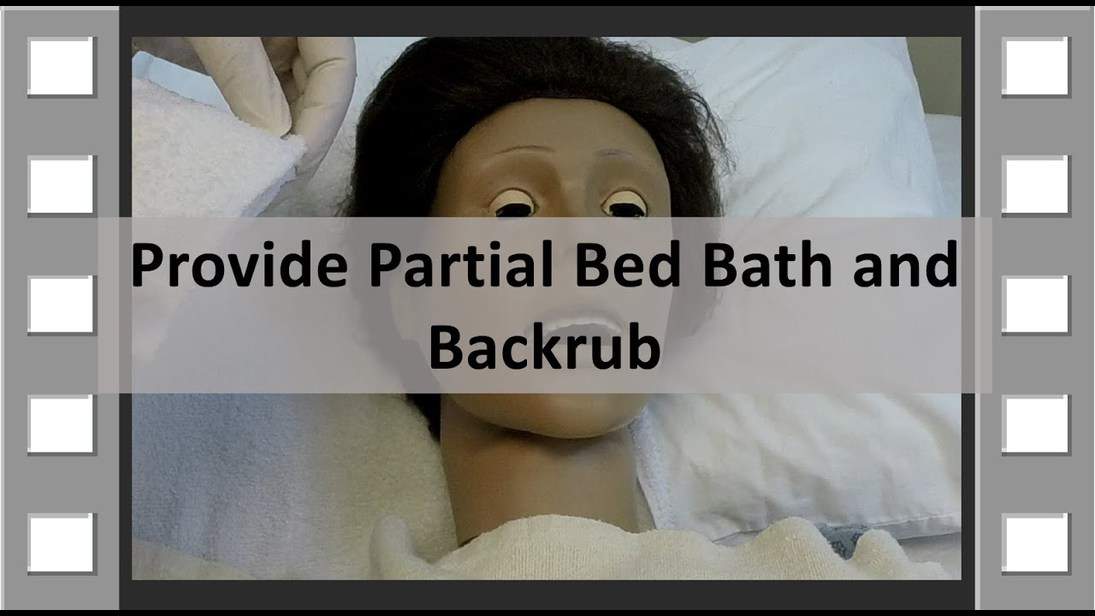
12:56
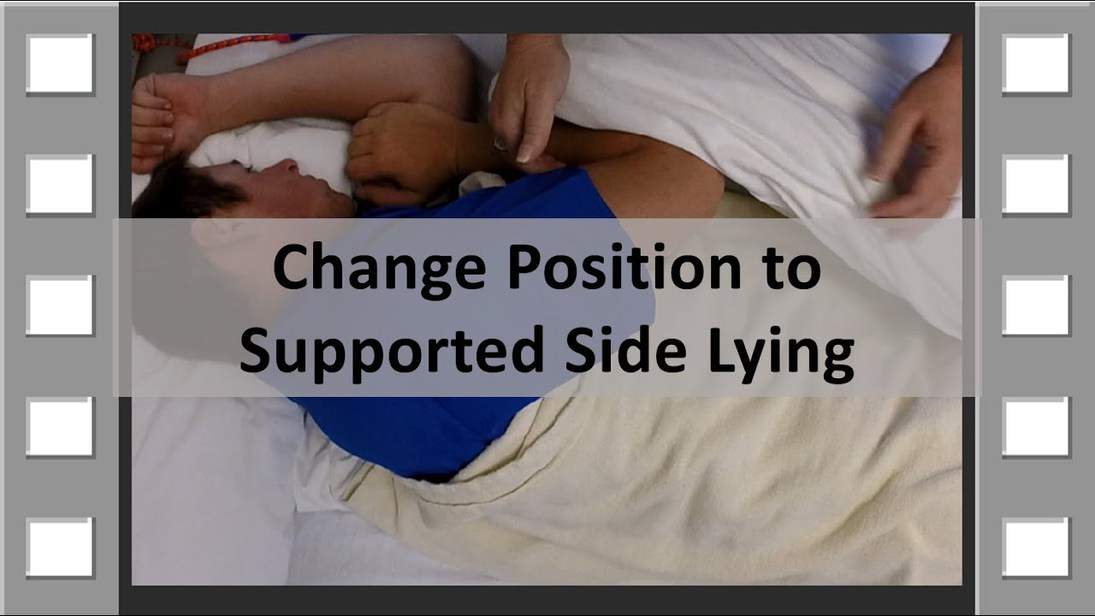
5:01
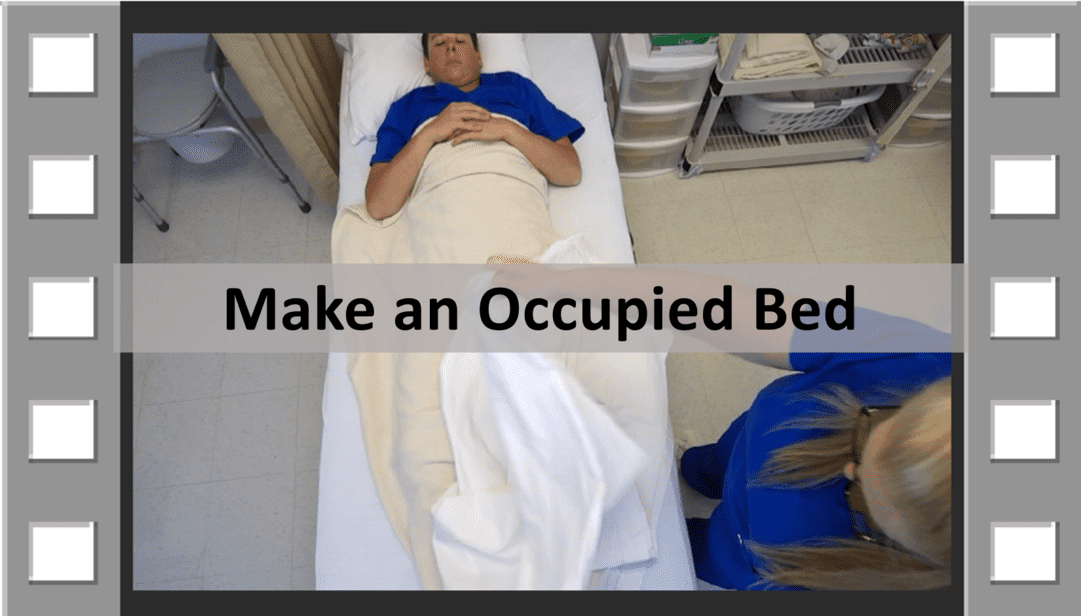
8:01

6:12

0:00

10:52
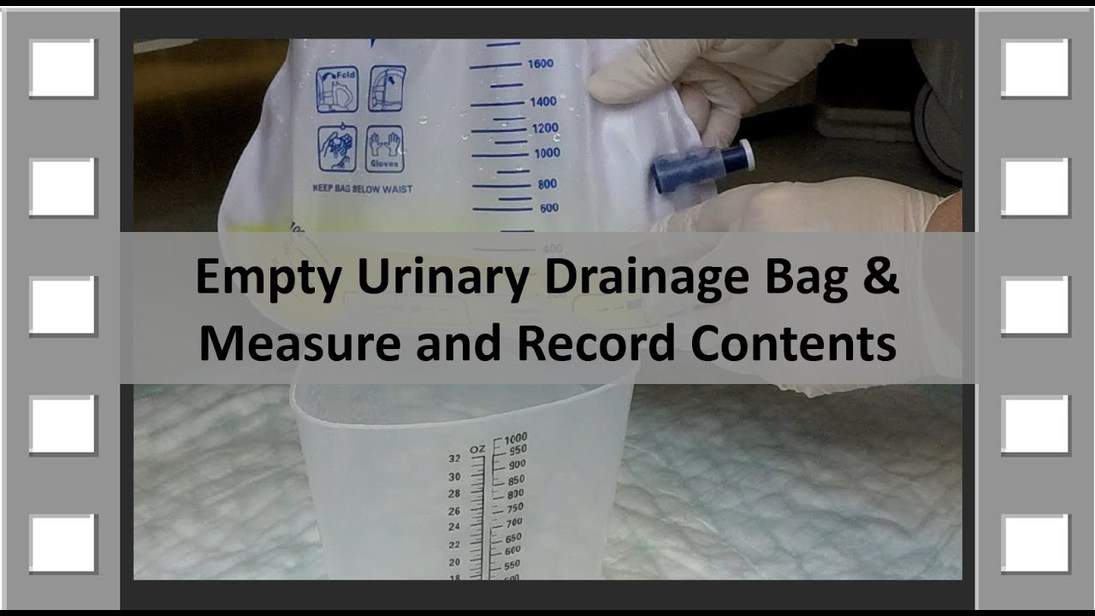
5:13
Wash your hands with soap and water using friction for at least 20 seconds before and after every patient encounter.
1. Turn faucet on and wet hands |
2. Apply soap, keep hands lower than elbows over sink |
3. Look at clock to begin timing friction |
4. Circle wrists, rub back of hands, between fingers, bottom of hands by pinky and palm of hands for at least 20 seconds, using clock to time |
5. Clean cuticles and under nails |
6. Rinse wrists and hands – do not touch sink or faucet |
7. Tap hands over sink so excess water drops into sink (don’t shake) |
8. Dry hands with paper towels, dispose of paper towels |
9. Turn off faucet with clean, dry paper towel – discard into trash |
Patient will be lying in bed for skill. Take the patient’s radial pulse, measured at the wrist, for one full minute and record your readings.
1. Opening & wash hands |
2. Locate pulse on thumb side of patient’s wrist |
3. Look at clock and say “Start” out loud |
4. Count beats (thumps you feel under your fingers) for one full minute (count silently) |
5. Say “Stop” out loud at end of full minute |
6. Perform closing and wash hands |
7. Document |
8. **Florida only: repeat with second evaluator |
Patient will be lying in bed for skill. Count the patient’s respirations for one full minute and record your readings.
1. Opening & wash hands |
2. Place alcohol pad on patient’s abdomen (if desired) |
3. Look at clock and say “Start”; count breaths for one full minute |
4. Say “Stop” out loud at end of full minute |
5. Dispose of alcohol pad (if used) |
6. Perform closing and wash hands |
7. Document |
Ambulate the resident at least 10 steps. Use a gait belt or transfer belt. Patient will be sitting in chair at side of bed with shoes on. Patient is able to walk but needs assistance to stand.
1. Opening & wash hands |
2. Get gait belt; identify if patient has non-skid footwear on |
3. Place gait belt on patient, around waist, buckle in front |
4. Ensure 4 fingers between gait belt and person |
5. Assist patient to stand by holding back or sides of gait belt |
6. Ask about dizziness; hold back of gait belt with one hand on farthest side (behind patient) with patient’s arms at sides |
7. Walk slightly behind and to one side; let patient lead; walk 5 steps |
8. Have patient turn and return to chair in same manner |
9. Ask frequently about dizziness, weakness and comfort |
10. Assist patient to back knees up to chair; gently lower into chair |
11. Remove gait belt |
12. Closing & wash hands |
Transfer the resident from bed into the wheelchair. The resident is unable to walk or take steps, but can stand with support. A gait belt or transfer belt is required to transfer the resident. The resident will stay in the room.
1. Opening & wash hands |
2. Get gait belt; prepare wheelchair (open and footrests out of way) |
3. Pivot patient into sitting position on side of bed |
4. Place footwear on patient, place feet flat on floor |
5. Place gait belt on patient, around waist, buckle in front |
6. Ensure 4 fingers between gait belt and person |
7. Bring wheelchair to side of bed; lock wheels |
8. On count of 3, grasp back of gait belt to stand and pivot patient |
9. When back of knees are against seat, gently lower into seat |
10. Have patient adjust hips as needed; remove gait belt |
11. Move wheelchair to adjust leg supports and footrests; lock wheels |
12. Closing & wash hands |
Provide the following range of motion (ROM) exercise to the resident’s left shoulder: flexion/extension and abduction/adduction. Provide three (3) repetitions of each exercise. The resident is not able to help with the exercises.
1. Opening & wash hands |
2. Explain all exercises before proceeding |
3. Flexion/extension of shoulder (up and down like asking a question) |
4. Abduction/adduction of shoulder (side to side like making a snow angel) |
5. Repeat each exercise three times |
6. Monitor for signs of pain |
7. Closing & wash hands |
Provide the following range of motion (ROM) exercise to the resident’s right elbow and right wrist: flexion/extension. Provide three (3) repetitions of each exercise. The resident is not able to help with the exercises.
1. Opening & wash hands |
2. Explain all exercises before proceeding |
3. Flexion/extension of elbow (up and down like making a muscle) |
4. Flexion/extension of wrist (up and down like revving a motorcycle) |
5. Repeat each exercise three times |
6. Monitor for signs of pain |
7. Closing & wash hands |
Provide the following range of motion (ROM) exercise to the resident’s right hip, knee and ankle: flexion/extension. Provide three (3) repetitions of each exercise. The resident is not able to help with the exercises.
1. Opening & wash hands |
2. Explain all exercises before proceeding |
3. Flexion/extension of hip and knee (up and down like climbing stairs) |
4. Flexion/extension of ankle (up and down like pressing down a gas pedal) |
5. Repeat each exercise three times |
6. Monitor for signs of pain |
7. Closing & wash hands |
A resident with natural teeth is lying in bed and needs mouth care. The resident is not able to provide their own mouth care.
1. Opening |
2. Elevate head of bed & adjust pillow; wash hands |
3. Place barrier on table; gather supplies; put towel on patient’s chest |
4. Wet toothbrush & apply toothpaste; apply gloves |
5. Brush top, bottom, front and back of teeth and gums |
6. Brush tip of tongue |
7. Allow resident to rinse and spit until comfortable |
8. Dry mouth with towel; remove towel and place in hamper |
9. Clean and store supplies; dispose of trash; remove gloves |
10. Perform closing & wash hands |
A resident with dentures is sitting at an overbed table with their dentures in a denture cup. The resident’s denture needs to be brushed with toothpaste and the resident needs mouth care. The denture is stored in a denture cup after cleaning. The resident is not able to provide own mouth or denture care.
1. Opening & wash hands |
2. Place barrier on table; gather supplies; prepare denture brush |
3. Take denture cup to sink; place washcloth in sink; apply gloves |
4. Turn cold water on with paper towel |
5. Brush all surfaces with denture brush (prepared with toothpaste) |
6. Rinse well, make sure you remove all toothpaste |
7. Rinse denture cup, fill with cool water |
8. Place dentures in denture cup filled with water, put lid on |
9. Store on paper towel on bedside table; remove denture gloves |
10. Perform “Mouth care with teeth” with new gloves |
11. Clean and store supplies; dispose of trash; remove gloves |
12. Perform closing & wash hands |
Dress the resident in a long-sleeved button-front or snap-front shirt, pants and socks. The resident is lying in bed and has a weak right arm. The resident is not able to help with dressing. After dressing, leave the resident in bed.
1. Opening & wash hands |
2. Place barrier on table; gather clothing; ask what they want to wear |
3. Place privacy blanket on patient, pull down sheet underneath |
4. Place socks and pants on patient; raise head of bed |
5. Undress STRONG arm first (USA first), then undress weak arm |
6. Dress WEAK arm first, then dress stronger arm |
7. Ensure clothing is neat and appropriately fastened |
8. Ask if resident wants sheet on |
9. Remove privacy blanket; place blanket and gown in hamper |
10. Perform closing & wash hands |
Feed a resident a snack who is unable to feed him/herself. The resident is sitting in a chair, in an inappropriate position for eating. Document intake on a food and fluid intake form.
1. Opening & wash hands |
2. Ask resident to sit in a fully upright position |
3. Give patient a hand wipe to wash hands |
4. Offer a clothing protector |
5. Sit facing resident at eye level; offer beverage |
6. Feed slowly, spoon ½ full, offer encouragement and conversation |
7. Offer drink every 2-3 bites |
8. Clean resident’s face, dispose of food items |
9. Perform closing & wash hands |
10. Document intake on food and fluid intake form |
Provide hand and nail care to one hand. The patient is sitting in a chair at the bedside and can move as directed.
1. Opening & wash hands |
2. Put barrier on table; gather supplies and put on barrier |
3. Fill basin with water; ask patient to check water |
4. Soak hand; remove hand (rest on towel); wring out a washcloth |
5. Apply soap to wet washcloth; wash resident’s hand |
6. Return hand to basin to rinse with 2nd washcloth |
7. Remove hand (rest on towel) to dry |
8. Clean under nails using orange stick; wipe off between nails |
9. File nails in one direction (toward middle) using emery board |
10.Warm lotion and apply; wipe off excess lotion with towel |
11. Clean and store supplies, dispose of dirty linens |
12. Perform closing & wash hands |
Provide foot care to one foot using soap and water. The resident is sitting in a chair and their sock and shoe should be replaced at the end of the skill.
1. Opening & wash hands |
2. Put barrier on floor; gather supplies and put on barrier |
3. Fill basin with water; ask patient to check water |
4. Place basin on barrier on floor; apply gloves |
5. Soak foot; remove foot (rest on towel); wring out a washcloth |
6. Apply soap to wet washcloth; wash resident’s foot; inspect skin |
7. Return foot to basin to rinse with 2nd washcloth |
8. Remove foot from basin (rest on towel) to dry |
9. Warm lotion and apply (except between toes); wipe off excess lotion with towel |
10. Put sock and shoe on |
11. Clean and store supplies, dispose of dirty linens; remove gloves |
12. Perform closing & wash hands |
Give the resident a partial bedbath and a backrub. Wash the resident’s face, neck, chest, abdomen, back and one arm and hand with soap and water. Provide a brief backrub with lotion. Dress the resident in a hospital gown. Patient is lying on back in center of bed and can roll as directed, but is too weak to assist with bathing.
1. Opening & wash hands |
2. Put barrier on table; gather supplies and put on barrier |
3. Fill basin with water; ask patient to check water |
4. Place bath blanket over patient; pull sheet down to waist |
5. Place towel under closest arm, shoulder and neck |
6. Untie patient gown and remove from arm and torso |
7. Apply gloves; wring washcloth out (no soap) and wash each eye using leaves method and remainder of face; dry |
8. Apply soap to 2nd washcloth; wash behind ear, neck, chest, abdomen, side, arm, hand and armpit; rinse and dry |
9. Dress in clean gown and roll patient onto side |
10. Wash, rinse, dry back; give backrub with lotion; wipe off excess; tie gown |
11. Clean and store supplies, dispose of dirty linens; remove gloves |
12. Pull sheet up; remove privacy blanket (place in hamper) |
13. Perform closing & wash hands |
Position the resident on his left side. Patient requires support to remain on his side and is unable to assist with turning.
1. Opening & wash hands |
2. Put barrier on table; gather supplies and put on barrier |
3. Place bath blanket over patient; pull sheet down to end of bed |
4. Have patient move to side of bed closest to you |
5. Move patient’s farthest arm up over patient’s head |
6. Place patient’s closest arm across chest |
7. Bend closest knee so that foot is flat on mattress |
8. Angle farthest knee outward; Roll patient onto side facing away from you |
9. Place pillow behind back, tuck long edge under back, roll upward and tuck second edge under back (making a roll behind the patient) |
10. Place pillow between knees and ankles |
11. Place pillow under top arm; adjust pillow under head |
12. Check head and bottom arm for positioning; place call light in hand |
13. Pull sheet up; remove privacy blanket (place in hamper) |
14. Perform closing & wash hands |
Change the top sheet, bottom sheet and pillowcase while the resident remains in bed. Resident can roll and move as directed but cannot get out of bed. A bedspread, blanket, drawsheet or underpad is not required for this skill.
1. Opening & wash hands |
2. Put barrier on table; gather supplies and put on barrier |
3. Place bath blanket over patient; remove top sheet, rolling in ball and place in hamper |
4. Have patient move to side of bed closest to you & roll toward center |
5. Roll dirty bottom sheet toward patient and tuck under entire body; look for objects |
6. Place clean bottom sheet on mattress, secure corners |
7. Roll clean sheet toward you and tuck under dirty all along the length of body |
8. Have patient return to center of bed on back; move to other side of bed |
9. Repeat step #4, remove soiled bottom sheet; roll into ball and put in hamper; smooth out clean sheet and attach corners to mattress – MINIMIZE WRINKLES |
10. Return patient to back in center of bed |
11. Replace top sheet; secure with hospital corners; remove privacy blanket to hamper |
12. Replace pillowcase; opening facing away from door; remove barrier and throw away |
13. Perform closing & wash hands |
The resident has requested a bedpan. The resident is not wearing undergarments and is able to wipe self. The resident is able to move as directed.
1. Opening & wash hands |
2. Cover resident with bath blanket, pull sheet down |
3. Apply gloves; Place clean chucks under patient |
4. Place bedpan under patient; give patient toilet paper |
5. Remove gloves; elevate head of bed |
6. Provide call light and leave area |
7. When patient calls, lower head of bed; apply gloves |
8. Remove bedpan and chucks together |
9. Empty bedpan in toilet; rinse into toilet; dry and store bedpan; remove gloves |
10. Give patient hand wipe to wash hands; dispose |
11. Replace sheet and remove bath blanket (place in hamper) |
12. Perform closing & wash hands |
The female patient has been incontinent of urine and needs perineal care. The pad under the resident is wet, but the hospital gown and bedding is dry.
1. Opening & wash hands |
2. Put barrier on table; gather supplies; roll chucks |
3. Fill basin with water; let patient check water |
4. Place bath blanket over patient, pull sheet down to knees |
5. Apply gloves; change underpad under patient |
6. Wash perineal area from front to back using “Leaves” method (5 leaves); rinse and dry |
7. Roll patient away from you, wash anal area and buttocks from front to back; rinse and dry |
8. Place clean, dry underpad under patient |
9. Put soiled linens in hamper, clean and store supplies; remove gloves |
10. Replace sheet and remove privacy blanket (place in hamper) |
11. Perform closing & wash hands |
Provide catheter care with soap and water to a female resident with an indwelling urinary catheter. Clean the catheter tubing and perineal area only.
1. Opening & wash hands |
2. Put barrier on table; gather supplies; roll chucks |
3. Fill basin with water; let patient check water |
4. Place bath blanket over patient, pull sheet down to knees |
5. Apply gloves; place underpad under patient |
6. Wash catheter tubing moving away from body using “Leaves” method (4 leaves); rinse and dry |
7. Wash perineal area from front to back using “Leaves” method (5 leaves); rinse and dry |
8. Remove underpad from under patient; inspect catheter tubing & bag |
9. Put soiled linens in hamper, clean and store supplies; remove gloves |
10. Replace sheet and remove privacy blanket (place in hamper) |
11. Perform closing & wash hands |
Empty the resident’s urinary drainage bag into a graduate container and measure and record urinary output (in ml’s or cc’s) on intake and output form.
1. Opening & wash hands |
2. Place underpad on floor; apply gloves |
3. Get graduate container; Position graduate container on barrier, |
4. Open urine port on catheter bag; Position port over graduate container |
5. Lift drainage bag slightly to allow urine to drain into graduate container. Do not allow port to touch anything. |
6. Close clamp; return port to storage pocket; inspect catheter and tubing |
7. Transport graduate container and chucks to bathroom; measure in cc’s on a flat surface, on a barrier, at eye level to nearest line |
8. Empty, clean and store graduate container; remove gloves |
9. Perform closing & wash hands and document |
